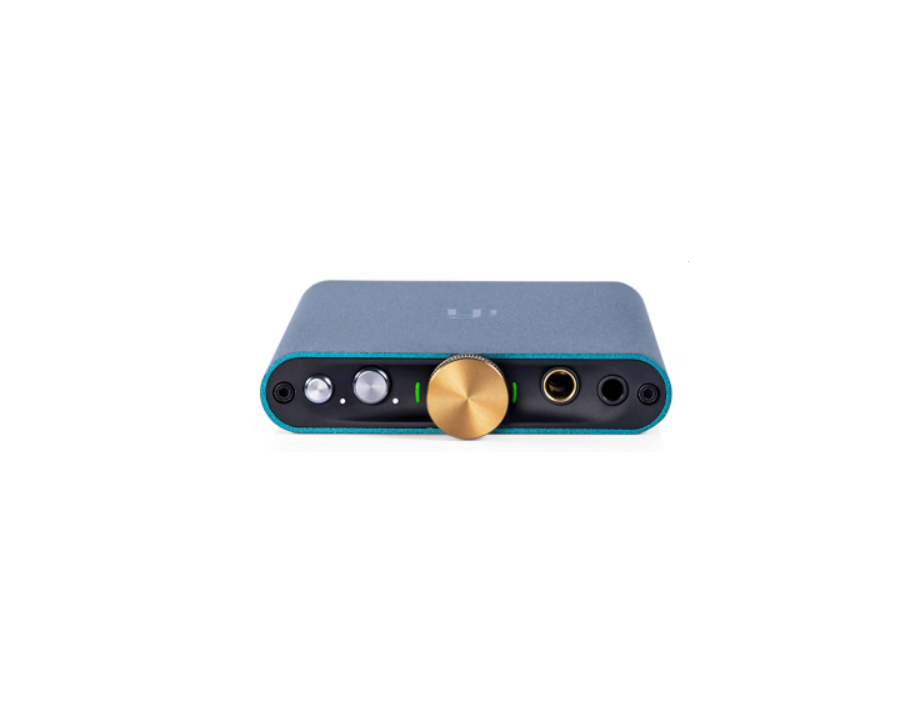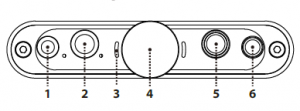iFi Audio hip-dac User Manual
1. Power Match® (on/off )
Power Match® enables hip-dac to match headphones’ impedance and sensitivity in order to generate their highest operational efficiency.Tip: For in-ear-monitors (earbuds) try Power Match® off. For headphones try Power Match® on.
2. XBass® (on/off)
Many headphones lack the correct bass response. XBass® is an analogue circuit designed to ‘add back’ the lost bass response for a more accurate reproduction of the original music.
3. Audio Format LED (kHz)
The LED colour scheme indicates the audio format and sampling frequency received by hip-dac from the music source.
LED Mode
Green 44/48/88/96kHzYellow 176/192kHz DXD352/384kHzCyan DSD128/DSD64 2.8/3.1/5.6/6.2MHzBlue DSD256 11.2/12.2MHzMagenta MQAOff No valid signal
4. ON/OFF and Analogue Volume Control
The analogue volume control in hip-dac is superior to any digital volume control.Warning: Due to the high power of hip-dac, always start off at a low volume level so that there is no risk of damage to your headphones and your hearing. iFi audio is notresponsible for any hearing or equipment damage from misuse.
Tip: hip-dac will continue to use battery power even if the USB cable is connected afterwards.Tip: For connection to Apple devices, Apple Lightning to USB Camera Adapter is required. For connection to Android devices, USB On-The-Go (OTG) cable and appropriate OS support are required.For more information, please refer to www.ifi-audio.com.
5. Balanced 4.4mm headphone output
Connect balanced 4.4mm headphones.
6. Single-ended 3.5mm headphone output
Connect single-ended 3.5mm headphones.

7. USB3.0 ‘Type A’ data input port
Connect your phone to hip-dac with Lightning to USB Camera Adapter (Apple) or USB On-The-Go (OTG) cable (Android). Whenusing other audio sources connect with a USB cable.Tip: It is preferable to use a USB 3.0 port over using a USB 2.0 port on the PC.
8. USB-C (5V) battery charge input
For charging only. It will take ~3 hours for a high-powered USB charger to fully charge hip-dac.
9. LED for Battery Status
LED Status
White* > 75%Green* > 25%Red* > 10%Red (flashing) ≤ 10%
*Battery LED will flash when it is charging
Specifications
| Formats supported: | DSD256/128/64,Octa/Quad/Double/Single-Speed DSDDXD(384/352.8kHz),PCM(384/352.8/192/176.4/96/88.2/48/44.1kHz)MQA |
| Digital Inputs: | USB 3.0 type ’A’High-Speed Asynchronous USB 2.0(32bit/384kHz) |
| Headphone Output | Balanced 4.4mmSingle-Ended 3.5mm |
| Power Output: | BAL:Ω; ΩS-BAL(SE): Ω; Ω |
| Battery: | Lithium-polymer 2200mAh |
| Power System: | Charging via USB-CBC V1.2 compliant up to 1000mAcharging current |
| Power (max): | <2W idle, 4W max |
| Dimensions: | 102(l) x 70(w) x 14(h) mm |
| Weight: | 125g (0.28 lbs) |
| Warranty period: | 12 months |
Specifications are subject to change without notice.
Read More About This Manual & Download PDF:
References
[xyz-ips snippet=”download-snippet”]


